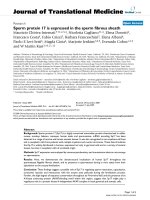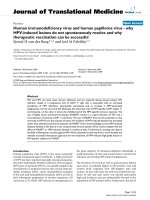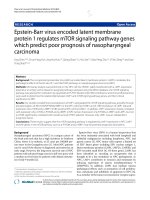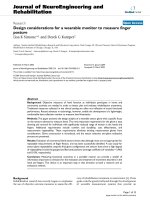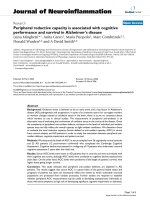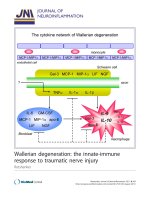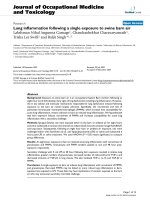Báo cáo hóa học: " Deformed wing virus is not related to honey bees'''' aggressiveness" potx
Bạn đang xem bản rút gọn của tài liệu. Xem và tải ngay bản đầy đủ của tài liệu tại đây (212.35 KB, 4 trang )
BioMed Central
Page 1 of 4
(page number not for citation purposes)
Virology Journal
Open Access
Short report
Deformed wing virus is not related to honey bees' aggressiveness
Agnès Rortais
1
, Diana Tentcheva
2
, Alexandros Papachristoforou
3
,
Laurent Gauthier*
2
, Gérard Arnold
1
, Marc Edouard Colin
2
and Max Bergoin
2
Address:
1
Laboratoire Populations, Génétique, Evolution CNRS, UPR 9034, avenue de la Terrasse, 91198 Gif-sur-Yvette –, France,
2
Laboratoire de
Pathologie Comparée des Invertébrés EPHE, UMR 1231, Biologie Intégrative et Virologie des Insectes INRA, Université Montpellier II, Place
Bataillon, 34095 Montpellier –, France and
3
Laboratory of Apiculture-Sericulture, School of Agriculture, Aristotle University of Thessaloniki –,
Greece
Email: Agnès Rortais - ; Diana Tentcheva - ; Alexandros Papachristoforou - ;
Laurent Gauthier* - ; Gérard Arnold - ; Marc Edouard Colin - ;
Max Bergoin -
* Corresponding author
Abstract
Guards of Cyprian honey bee colonies, Apis mellifera cypria, display a great defensive behaviour
against hornets' attacks. The deformed wing virus (DWV) and the kakugo virus (KV) genomes are
very similar, but unlike KV, the presence of DWV is not related to honey bees' aggressiveness. This
discrepancy is further discussed.
Findings
Temporal polyethism is widespread among social
hymenopteran, and particularly in the honey bee Apis mel-
lifera L. [1,2]. The behavioural shifts that occur as a worker
ages are associated with physiological changes such as var-
iation in juvenile hormone titres in the insect haemol-
ymph [3] or variation in octopamine levels in the bee
head [4]. As the expression patterns of the mRNA in
honey bee brains predict behavioural changes [5], one can
expect that viral infections located in heads might have
profound effects on the behaviour of bees. Until now,
only one insect virus – namely the sacbrood virus (SBV),
has been found to modify workers tasks. SBV infected
adults were found to forage earlier in life than controls,
and most infected foragers failed in collecting pollen;
these effects were attributed to physiological changes due
to viral infection [6,7]. Recently, the kakugo virus (KV),
which was only detected in the brain of aggressive workers
of Italian bees by real-time PCR, was suggested to trigger
behavioural changes in honey bees [8].
Among the 13 honey bee viruses described in Apis mellif-
era L. [9], the deformed wing virus (DWV) is one of the
most common [10-12]. DWV belongs to the novel family
of the Iflaviridae and its genome consists of a single strand
positive RNA encompassing a single open reading frame
which codes for both structural and non structural
polypeptides [13]. DWV is suspected to induce typical
injuries on the wings of infected workers, mostly in those
heavily infested with the ectoparasite Varroa destructor [9].
In honey bee colonies, association of DWV with mite
infestations has been largely documented [10,14-16].
DWV was further evidenced in different worker, queen
and drone organs by quantitative RT-PCR and in situ
hybridisation [17,18] indicating that it might have a con-
siderable degree of tissue specificity.
The DWV and KV sequences show a great homology
(98%, at the nucleotide level). Considering this, we tested
whether DWV, like KV, is related to honey bees' aggres-
siveness by comparing DWV RNA loads in aggressive
Published: 30 August 2006
Virology Journal 2006, 3:61 doi:10.1186/1743-422X-3-61
Received: 24 March 2006
Accepted: 30 August 2006
This article is available from: />© 2006 Rortais et al; licensee BioMed Central Ltd.
This is an Open Access article distributed under the terms of the Creative Commons Attribution License ( />),
which permits unrestricted use, distribution, and reproduction in any medium, provided the original work is properly cited.
Virology Journal 2006, 3:61 />Page 2 of 4
(page number not for citation purposes)
(guards) versus non aggressive honey bees (emerging bees,
nurses and foragers) issued from several colonies of Apis
mellifera cypria, a race that exhibits a great defensive behav-
iour against the hornet Vespa orientalis [19].
Honey bees (Apis mellifera cypria) were collected in an api-
ary located in the southern part of Cyprus in three sam-
pling times (October and November 2004, and April
2005). For each sampling time, 10 guards and 10 nurses
were collected in 5 colonies (total of 300 individuals),
and during the last sampling, 5 more colonies and 2 other
temporal castes (emerging bees and foragers) were sam-
pled (total of 100 additional individuals). Emerging bees
were collected directly in brood cells and nurses on brood
combs. Guards were trapped on flight boards using a liv-
ing hornet as lure, and foragers were collected when
returning to the hive with pollen pellets. All samples were
stored in ethanol (95%) and DWV RNA loads were deter-
mined by quantitative RT-PCR, using a standardised pro-
tocol [16]. Each analysis was representative of a pool of 10
individuals and heads were analysed separately from tho-
raxes and abdomens.
DWV RNA loads recorded in the different bee samples
were compared using the SigmaStat 2.03 software (Sys-
tat). A Mann-Whitney Rank Sum Test showed no statisti-
cal differences between nurses and guards collected
during the three sampling times (in bodies, guards versus
nurses: T = 294.500, P = 0.428 ; in heads, guards versus
nurses: T = 350.000, P = 0.820). Likewise, the DWV RNA
loads recorded in the 10 colonies collected in April 2004
showed no statistical differences, neither among the four
temporal castes nor between body parts (ANOVA on
ranks: H = 1.541; df = 3; P = 0.673). Data are presented on
Figure 1.
For comparisons, DWV RNA loads were determined in
nurses and guards using KV [8] and DWV [16] primers.
Each couple of primers displayed similar PCR efficiency
(DWV: y = -3.26 x + 17.12; R
2
= 0.998 – KV: y = -3.24 x +
17.75; R
2
= 0.990), but never allowed to distinguish differ-
ent viral populations according to the standard error gen-
erated by the technique [16].
In this paper, we showed that infection of A. m. cypria by
DWV is common in all colonies and that there are no sig-
nificant differences among temporal castes and body
parts. Thus, despite their high genome homology, KV and
DWV display distinct biological patterns. In order to
explain such discrepancies, several hypotheses are pro-
posed.
Small changes in the amino acid composition of DWV
and KV might be sufficient to modify their viral tissue tro-
pism such that one variant, the KV, specifically targets the
brain of the honey bee and be responsible for the
observed behavioural changes. The genome of these two
viruses show a higher polymorphism in the putative
leader polyprotein coding region which has already been
found to be associated with viral pathogenesis [13].
The behaviour of these two viruses may also vary with the
origin of honeybees (e.g. race, colony). While KV and
DWV are detected in the heads of asymptomatic Italian
(A. m. ligustica) [8] and Cyprian (A. m. cypria) honeybees,
respectively, DWV is not detected in the head of asympto-
matic German (A. m. carnica) honeybees [20]. According
to the race and/or the origin of colonies, KV and DWV
may not have the same viral tissue tropism. However,
given that 10 colonies of A. m. cypria honeybees were ana-
DWV RNA values recorded in the head (A) and body (B) of bees issued from 10 colonies of A. mellifera cypria in April 2004Figure 1
DWV RNA values recorded in the head (A) and body (B) of
bees issued from 10 colonies of A. mellifera cypria in April
2004. EM: emerging bees; NU: nurses; GU: guards; FO: forag-
ers. Results are representative of 10 individuals and are
expressed as mean of triplicates in number of DWV RNA
copies per body part (head or thorax and abdomen). The
number of negative DWV samples is indicated into brackets.
Virology Journal 2006, 3:61 />Page 3 of 4
(page number not for citation purposes)
lysed whereas only two colonies of'A. m. ligustica were
analysed for the study of KV [8], one cannot exclude that
the effects of inter-colonial variations may have been less
significant for the detection of KV than for the detection
of DWV. This sampling bias poses a serious flaw on the
significance of the results previously found [8].
Given the high degree of identity between DWV and KV
sequences, it is difficult to design primers specific enough
to distinguish between the sequences of the two viruses
from a single one bee population. DWV was previously
detected by PCR in approximately 60% of colonies [11]
suggesting that KV must be absent from 40% of colonies.
However, all colonies have guards which aggressivity vary
with environmental conditions such as humidity, heat,
and nectar availability [21,22]; Thus, it seems very
unlikely that the presence of KV or DWV has any relation
with the aggressiveness of guards. The absence of any sig-
nificant relation between the presence of DWV and the
aggressiveness of Cyprian honeybees supports this
assumption. More likely, the intensity of the defensive
reaction depends on interactions between individuals and
between environmental and genetic effects (see [23] for a
review).
There is now a strong evidence that DWV could spread out
among colonies independently of mites infestation, that
is by food secretions from nurses to larvae or from queen
to workers [18]. The mite, Varroa destructor, is responsible
for the spreading of DWV in all bee tissues by haemol-
ymph spoliation and reactivation of viral infections [15].
Thus, one can assume that in the absence of the mite,
DWV and KV might specifically target bee heads where
they further concentrate. Therefore, it is possible that the
data recorded by Fujiyuki et al. (2004) and those pre-
sented in this study reflect different levels of mite infesta-
tion among colonies. RNA viruses are generally
distributed as quasispecies [24], representing a popula-
tion made of a cloud of genetic variants. Recently, this
population genetic diversity was found to determine
pathogenesis through cooperative interactions [25]. It
would be challenging to understand why some honey
bees colonies (e.g. Cyprian and Italian honey bees) might
host particular types of viruses (e.g. DWV and KV) with
specific tropisms and different levels of pathogenicity. In
that, assuming that DWV replicates in V. destructor, one
can hypothesizes that mites can influence the genetic out-
come of viral populations as it has recently been suggested
[20].
Competing interests
The author(s) declare that they have no competing inter-
ests.
Authors' contributions
AR and DT contributed equally to this work. AR and AP
performed field experiments. DT did the quantitative PCR
analysis. LG and AR planed the experiments and wrote the
manuscript. MEC did the statistical analysis. GA, MEC and
MB contributed to the design of the experiments and
revised the manuscript. All authors read and approved the
final manuscript.
Acknowledgements
We thank Mr Varnava, President of the Cypriot Beekeepers Union, for his
collaboration and support, and Mr Kallenos for offering 40 colonies for the
experiment. This work was supported by the EC, the French Ministry of
Agriculture (CE/1221/97), EGIDE, and the Research Promotion Foundation
of Cyprus.
References
1. Robinson GE: Regulation of division of labor in insect societies.
Ann Rev Entomol 1992, 37:637-665.
2. Winston ML: The biology of the honey bee. Edited by: Press HU.
Cambridge, ; 1987.
3. Robinson GE, Page RE, Strambi C, Strambi A: Hormonal and
genetic control of behavioral integration in honey bee colo-
nies. Science 1989, 246:109-112.
4. Wagener-Hulme C, Kuehn JC, Schultz DJ, Robinson GE: Biogenic
amines and division of labor in honey bee colonies. J Comp
Physiol 1999, 184:471-479.
5. Whitfield CW, Cziko AM, Robinson GE: Gene expression profiles
in the brain predict behavior in individual honey bees. Science
2003, 302:296-299.
6. Bailey L, Fernando EFW: Effects of sacbrood virus on adults
honey-bees. Ann Appl Biol 1972, 72:27-35.
7. Anderson DL, Giacon H: Reduced Pollen Collection by Honey-
Bee (Hymenoptera, Apidae) Colonies Infected with
Nosema-Apis and Sacbrood Virus. Journal of Economic Entomol-
ogy 1992, 85:47-51.
8. Fujiyuki T, Takeuchi H, Ono M, Ohka S, Sasaki T, Nomoto A, Kubo
T: Novel insect picorna-like virus identified in the brains of
aggressive worker honeybees. J Virol 2004, 78:1093-1100.
9. Bailey L, Ball BV: Honey Bee Pathology. 2nd edition. London, Har-
court Brace Jovanovich; 1991:193.
10. Nordstrom S, Fries I, Aarhus A, Hansen H, Korpela S: Virus infec-
tions in Nordic honey bee colonies with no, low or severe
Varroa jacobsoni infestations. Apidologie 1999, 30:475-484.
11. Tentcheva D, Gauthier L, Zappulla N, Dainat B, Cousserans F, Colin
ME, Bergoin M: Prevalence and seasonal variations of six bee
viruses in Apis mellifera L. and Varroa destructor mite pop-
ulations in France. Appl Environ Microbiol 2004, 70:7185-7191.
12. Allen M, Ball B: The incidence and world distribution of honey
bee viruses. Bee World 1996, 77:
141-162.
13. Lanzi G, de Miranda JR, Boniotti MB, Cameron CE, Lavazza A, Capucci
L, Camazine SM, Rossi C: Molecular and biological characteriza-
tion of deformed wing virus of honeybees (Apis mellifera L.).
J Virol 2006, 80:4998-5009.
14. Bowen-Walker PL, Martin SJ, Gunn A: The transmission of
deformed wing virus between honeybees (Apis mellifera L.)
by the ectoparasitic mite varroa jacobsoni Oud. J Invertebr
Pathol 1999, 73:101-106.
15. Shen M, Yang X, Cox-Foster D, Cui L: The role of varroa mites in
infections of Kashmir bee virus (KBV) and deformed wing
virus (DWV) in honey bees. Virology 2005, 342:141-149.
16. Tentcheva D, Gauthier L, Bagny L, Fievet J, Dainat B, Cousserans F,
Colin ME, Bergoin M: Comparative analysis of deformed wing
virus (DWV) RNA in Apis mellifera L. and Varroa destruc-
tor. Apidologie 2006, 37:41-50.
17. Fievet J, Tentcheva D, Gauthier L, de Miranda JR, Cousserans F, Colin
ME, Bergoin M: Localization of deformed wing virus infection
in queen and drone Apis mellifera L. Virology Journal 2006, 3:1-5.
18. Chen YP, Pettis JS, Collins A, Feldlaufer MF: Prevalence and trans-
mission of honeybee viruses. Appl Environ Microbiol 2006,
72:606-611.
Publish with BioMed Central and every
scientist can read your work free of charge
"BioMed Central will be the most significant development for
disseminating the results of biomedical research in our lifetime."
Sir Paul Nurse, Cancer Research UK
Your research papers will be:
available free of charge to the entire biomedical community
peer reviewed and published immediately upon acceptance
cited in PubMed and archived on PubMed Central
yours — you keep the copyright
Submit your manuscript here:
/>BioMedcentral
Virology Journal 2006, 3:61 />Page 4 of 4
(page number not for citation purposes)
19. Papachristophorou A, Rortais A, Arnold G, Ioannides I, Séraphides N,
Garnery L, Thrasyvolou A: Defensive behaviour of Apis mellif-
era cypria against the hornet Vespa orientalis.: ; Dublin, Ire-
land. ; 2005.
20. Yue C, Genersch E: RT-PCR analysis of Deformed wing virus in
honeybees (Apis mellifera) and mites (Varroa destructor). J
Gen Virol 2005, 86:3419-3424.
21. Guzman-Novoa E, Page RE: Selective breeding of honey bees
(Hymenoptera: Apidae) in Africanized areas. J Econ Entomol
1999, 92:521-525.
22. Southwick EE, Moritz RFA: Effects of meteorological factors on
defensive behavior of honey bee. Int J Biometeorol 1987,
31:259-265.
23. Breed MD, Guzman-Novoa E, Hunt G: Defensive behavior of
honey bees: organization, genetics, and comparisons with
other bees. Annu Rev Entomol 2004, 49:271-298.
24. Eigen M: On the nature of virus quasispecies. Trends Microbiol
1996, 4:216-217.
25. Vignuzzi M, Stone JK, Arnold JJ, Cameron CE, Andino R: Quasispe-
cies diversity determines pathogenesis through cooperative
interactions in a viral population. Nature 2005, 4:344-348.
